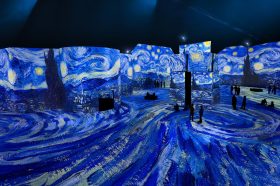Beginning this month, the Powerhouse NSW Creative Industries Residency Program provides a diverse array of artists and collectives with the rare opportunity to work in a subsidised space where they can not only potentially co-create work – gaining inspiration and advice from outside their own artform – but also have the chance to develop new programs.
The inaugural Powerhouse Residents include Anna Tregloan, interdisciplinary artist, writer and researcher Cat Jones; design studio Common Office founded by Rob Meyerson from Western Sydney University; designer and illustrator Dinalie Dabareral; Electronic Music Conference, founders of the EMC Festival and filmmaking collective Four Leg Films, Bistro and Birdland, consisting of multi-award winning duo Chris Thompson (producer) and Alex Barnett (post production supervisor) from Four Leg Films, producer Elliot Clifford (Bistro) and writer and director Kerinne Jenkins (Birdland).
The residents also include art and architecture duo Heidi Axelsen + Hugo Moline; sound designer Julian Wessels; Queer Screen, one of the largest film festivals in the Southern Hemisphere to celebrate LGBTQI+ lives, stories and culture; internationally renowned Australian fashion duo, Romance Was Born (Anna Plunkett and Luke Sales) and sculptor, video and installation artist Rosie Deacon.
Over 65 applications were received for the program, which will also support independent fashion designers, artists, and creatives who run film and electronic music festivals.
‘There is a need for sustained support for the creative industries sector and as an institution that works across design and technology, we’re very committed to providing that support,’ said Lisa Havilah, Chief Executive of Powerhouse Museum.
Collaboration
The Powerhouse residents come from a diverse field of practices and will work out of office spaces and specially built studio spaces within the Powerhouse Museum’s Ultimo site.
The spaces range from 25sqm to 50sqm (with larger spaces possible based on the requirements of residents) and, together with communal facilities, are available to residents for periods ranging from two months up to two years.
Havilah said providing a space where creatives can come to collaborate is critical for the ongoing development of creative practice.
‘In terms of moving the practice of an artist or a creative forward, collaborations can expand practice,’ she told ArtsHub.
‘We’re really interested to look at how we can embed a creative industry community into our institution in terms of supporting practice and how that practice can feed into our programs, whether that’s education programs, exhibition projects or commissions.
‘We’re also excited about how our residents will engage with our collections,’ she added.
Cross-fertilising disciplines
For Havilah, crafting a program that brings together people from different practices is an important part of the residency.
‘We really wanted to create a mix of disciplines because we thought that would also be interesting in terms of expanding both the practices of the organisations and the individuals,’ she said.
‘We really hope that as the residents get to know each other there’ll be cross-collaborations, not only with us but with each other.
‘We were looking for people who would really take on the opportunity and highly utilise the space and feed into our program because part of the subsidy is that each of the residents work with us on presenting a public facing program,’ Havilah said.
The potential also exists for creative new synergies between the programs of the Powerhouse and the activities of new residents Queer Screen and the Electronic Music Conference – organisations with significant experience in curating large scale programs.
The Electronic Music Conference has grown from a modest, two-day conference in 2012 into an annual program which last year featured over 70 artists across 14 events, attended by over 6,000 people.
Similarly, Queer Screen has grown from humble beginnings in 1993 to become one of the largest film festivals in the Southern Hemisphere celebrating LGBTQI+ lives, stories and culture.
‘I think there’s many ways we can expand our education and broader programs to present more screen work or present more music programs,’ Havilah said. ‘It’s really about us thinking expansively about our program but also having the industry and artists in the sector influence program development as well.’
It’s the energy of artists and creatives coming together and the potential of what they can contribute to the broader industry and community that has Havilah most excited.
‘The Powerhouse is in many ways a creative studio unto itself; we’re exhibition makers and programmers so having more diverse and new creative energy around us will be brilliant,’ she said.
‘I am really looking forward to these diverse collaborations, which will be great for our team but it will result to great effect for the community most importantly.’
For more information please visit Powerhouse Museum.





